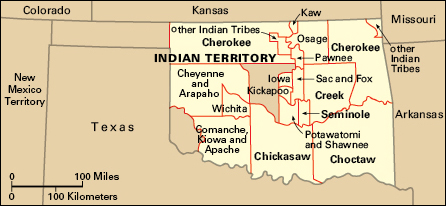The Chickasaw Nation
Friday, October 19th, 2018October 19, 2018
On Oct. 19, 1818, 200 years ago today, the Chickasaw Indians signed a treaty with the United States government that opened Chickasaw lands in western Tennessee and Kentucky to white immigration. In exchange for the land, the U.S. government paid the Chickasaw $20,000 per year for 15 years and forgave certain debts owed by the tribe. The treaty came after years of government pressure and the threat that Chickasaw lands would be taken whether they signed a treaty or not. Future U.S. President Andrew Jackson, then a major general in the U.S. Army, negotiated the 1818 agreement with the Chickasaw, who had ceded other nearby lands to white settlement in 1805 and in 1816.
Chickasaw territory originally included northern Mississippi, northwestern Alabama, and western Tennessee and Kentucky. The Chickasaw lived in villages of small, one-room log cabins. Each village was headed by a chief. The people supported themselves by farming, fishing, hunting, and trading with neighboring tribes. The Chickasaw were one of the so-called Five Civilized Tribes, a group that also included the Cherokee, Choctaw, Muscogee (Creek), and Seminole Indians. White settlers gave the tribes this name in the 1800′s, after the tribes had adopted a number of European customs. Many settlers considered European ways more civilized than Indian ones.
The Chickasaw were also fierce warriors. In 1541, they drove off an expedition led by Spanish explorer Hernando de Soto, and more than 200 years later, they helped Great Britain fight France and Spain for control of what is now the southeastern United States. Chickasaw warriors also fought for the British in the American Revolution (1775-1783) and for the Confederacy during the American Civil War (1861-1865).

Click to view larger image
The Indian Territory was land set aside by the U.S. government for Indians from about 1825 to 1906. It covered most of present-day Oklahoma. Credit: WORLD BOOK map
In the “Great Removal” of 1837, the U.S. government forced the Chickasaw from their remaining lands east of the Mississippi River to make room for additional white immigration. Thousands of Chickasaw died on the forced march to their new lands in the Indian Territory, a region west of the Mississippi that was temporarily set aside for the residence of Indians. In 1907, the Chickasaw and other Indian nations were forced into reservations when the Indian Territory became part of the new state of Oklahoma.
According to the 2010 census, there are about 28,000 Chickasaw today, most of whom live in Oklahoma. A tribal government elected by the Chickasaw helps provide for the nation’s general welfare.



